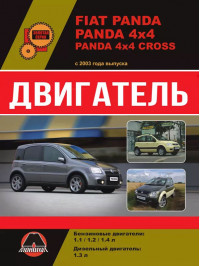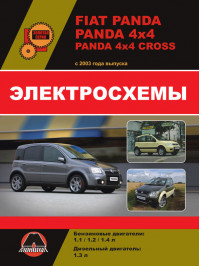Information on repair and maintenance of Fiat Panda cars electronically
The Fiat Panda is a small car from Fiat, the first series of which was produced from the spring of 1980 to the autumn of 2003 in a quantity of more than four million cars. This makes it one of the brand's most successful models.
The Fiat Panda was conceived by Giorgetto Giugiaro as a modern embodiment of the concept embodied in such iconic models as the Citroën 2CV and Renault 4 - simplicity and accessibility both in terms of the car itself and its maintenance. The model stood out with its angular, smooth shape - the window glass was flat. Because the body was easy to manufacture and the interior was spartan, such as covered tubular steel frame seats (early series and later base models) reminiscent of camp furniture, the car could be produced at low cost and offered relatively inexpensively.
Characteristics of Fiat Panda
The car debuted in 1980. The model was initially offered with two engine types: a small 562cc air-cooled two-cylinder unit (taken from the Fiat 126) and a 903cc four-cylinder water-cooled unit (produced for the Fiat 127).
In 1983, the Austrian company Steyr-Puch developed an all-wheel drive system, and the Fiat Panda 4x4 version with a 965 cm³ engine and 48 hp was born. It was the first small car equipped with an all-wheel drive system. This step was probably a response to the popularity of the Soviet Niva VAZ-2121, which in those years was in certain demand in Austria - to the point that it was purchased for the needs of the Austrian police.
In July 1984, the millionth Fiat Panda rolled off the assembly line, and by the end of 1985, about 1,400,000 copies of this model had already been reserved. The Fiat Panda received minor updates in 1986, and the set of engines was replaced with more powerful and economical modifications.
In 1990, Fiat introduced the Panda Elettra, a two-seater electric car. The batteries were located in the rear row of seats. The car initially weighed 1,150 kg, mainly due to the batteries, and produced 18 hp. However, by 1992, it was possible to reduce weight and increase power to 23.8 hp.
Despite its poor quality and tendency to rust, the Fiat Panda remained popular throughout the 1980s and the first half of the 1990s. At that time, many Fiat models were subject to corrosion. A total of 5,550,938 first-generation vehicles were produced.
When creating the second generation Fiat Panda (codenamed Model 169), the name "Gingo" was initially considered, but it strongly resembled the Renault Twingo, so the decision was made to keep the old name. In its design, the new Fiat Panda is more reminiscent of a microvan or micro-SUV than the first generation hatchback.
In 2004, the car was recognized as the best in Europe. Beginning in September 2005, all vehicles were equipped with ABS, EBD, stability control and front airbags as standard. On October 5, 2005, the 500,000th Fiat Panda II rolled off the production line. A total of 2,168,491 second-generation cars were produced.
According to the results of a crash test conducted in 2004 using the Euro NCAP method, the Fiat Panda received less than three stars for safety, which is a very good result for cars of that time. It scored 20 points for occupant protection, 21 points for child protection and 6 points for pedestrian protection.
The presentation of the third generation Fiat Panda took place at the Frankfurt Motor Show in 2011. The car was built on a modernized platform of the previous Fiat Panda model, and its dimensions increased: it became 10 cm longer and one higher. The engine range includes petrol engines of 1.0 and 1.2 liters (power 65 and 69 horsepower, respectively), as well as a 1.3 Multijet turbodiesel.
The Fiat Panda hatchback is available in four versions: Pop, Easy, Lounge and Trekking. The base model comes with 14-inch steel wheels, power front windows, and a four-speaker audio system with a CD player and MP3 support. Easy models are additionally equipped with remote central locking, air conditioning, a six-speaker audio system and roof rails.
The Lounge modification has alloy wheels and fog lights. And the Panda Trekking version received 15-inch alloy wheels, Blue&Me infotainment system with Bluetooth, TomTom navigation system, stability control and hill assist.
Fiat Panda service manual
On our website you can purchase and download a Fiat Panda car repair manual in PDF format. This guide will answer many questions, including:
- procedure for replacing oil and fuel filters;
- steps to repair the transmission yourself;
- method troubleshooting in the vehicle lubrication system and their elimination;
- main malfunctions of the engine electrical equipment and instructions for eliminating them yourself;
- rules for repairing brake pads and discs and much more.
This book can be downloaded to your smartphone, computer or tablet, where you can quickly find the information you need at any time. The Fiat Panda repair manual describes in detail the car's design, main characteristics, illustrations with detailed instructions for various repair work.








